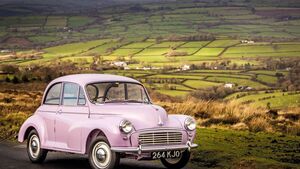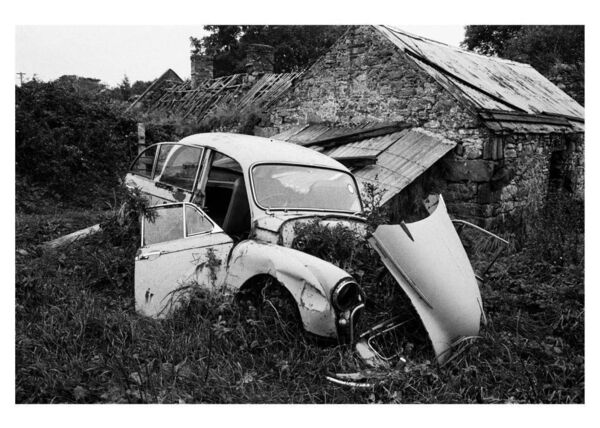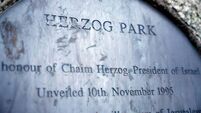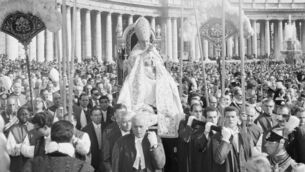The Morris Minor: a much-loved car of the 1960s

The Morris Minor was hugely popular in Ireland in the 1950s and 1960s.
In much the same way as the Ford Model T was a universal car in its time, so too was the Morris Minor. This simple car was a great favourite back in the 1950s and 1960s, endearing itself to townsfolk and country people alike.
I remember a time when many families in our locality proudly drove a Morris Minor. From memory, they were mostly black in colour but this only added to their style. They may not have been classy but they were a classic of their time.
Not that Jack Daniels! An article in the in December 2004 tells of another by that name and recounts the story of the man who helped design the Morris Minor. This particular Jack Daniels had died at the age of 92 just a month previously.
Daniels should be remembered as one of the most innovative carmakers ever. He was the draughtsman and development engineer without whom the Morris Minor would never have been brought into production.
Working with Alec Issigonis, the British automobile designer who also created the best-selling Mini, the pair began working together before the Second World War, but it was only when peace returned that their collaboration really took off. Issigonis had begun work on what would become the Morris Minor in 1943, at a time when Daniels was busy designing military vehicles. In 1945, he joined Issigonis on the design of the car, then known as the Mosquito, named after the war plane.
Manufactured by Morris Motors Limited, this great British car made its debut in 1948 and more than 1.6 million were manufactured between then and 1972. The original range consisted solely of a two-door saloon and a starting price of £358. It was the first British car to sell over a million units and is considered a supreme example of automotive design.
A 1952 motoring publication reported a top speed of 62mph, acceleration from 0 to 50mph in 28.6 seconds and a fuel consumption of 39.3 miles per gallon. In Ireland, the Morris Minor was assembled by G. A. Brittain at Portobello in Dublin. In fact, Ireland received the first Morris Minor car kits for assembly, making us the first country outside Britain to have Morris Minor production. After Australia and the US, Ireland was the third most important market for this much-loved car.
And so, the Minor found good homes among the Irish motoring public. It was black enough for the parish priest, reliable enough for the local doctor, fashionable enough for the sales executive, rugged enough for the farmer and handy enough for the lady driver. It was just as much at home in Foxford as it was in Foxrock. Seldom was something so British so totally accepted by the Irish.
The basic shape was complimented by the Traveller, the wood-trimmed estate version most associated with 1970s BBC sitcoms. There was another version, the commercial van. This van was my first experience of the Morris Minor at close quarters. I got a lift some mornings on my way to school from the van owner. Amazingly, he was using the van in his role as a milk carter. Those days, in the early 1970s, witnessed the dying spasms of the old milk carting tradition (usually undertaken by horse and long cart), before the co-ops and their bulk takers took over.
Carting the milk churns for about six or eight local farmers in the back of his van, the driver sailed along singing the only song he knew, . Slowly but surely, farm gate by farm gate, Billy picked up the cans of fresh milk destined for the creamery.
The interior of the grey van was absolutely putrid! Milk spillages that had occurred over the summer, hardened into autumn crusts and the residual stench had an intensity all of its own. Getting out of the van at the crossroads, I was glad of the fresh air and relieved at the prospect of a day at school.
The Morris Minor always had one eye on the sales of the Volkswagen Beetle. Maybe it was a post-war British versus German thing but whatever it was, the Beetle certainly won that war. Sales of the VW were worldwide while the Minor only had a market largely confined to the Commonwealth. Towards the end, the last few Morris Minors were actually sold at a loss.
The Minor was officially replaced by the Morris Marina, which was developed primarily in response to Ford's top-selling Escort. The Marina was developed under the watchful eye of British Leyland management where it beat all-comers in a race to the bottom. To cut costs, rather than develop a new suspension set-up, the Marina used the obsolete chassis components from the Morris Minor.
In a 2016 report, included the Marina on a list of the worst cars ever made describing it as “unreliable, ugly and terrible to drive".

David Carroll, who is probably best know to people in the Ox Mountain region for his exploits with his restored threshing machine, once had a long love affair with Morris Minors. In a newspaper article from the 1990s, in a tell-all interview with journalist, Meave Sheehan, he explained his motives.
“I don’t know what it was about them but I used to always look after them lovingly. If I met someone who had crashed one, I would take it home. I hated to see a Morris Minor abandoned or scrapped. There is a graveyard for everything.”
David eventually amassed a collection of almost 50 such cars which included a Morris Million, which he bought for £10 some years earlier. This was a pink car with black and white seats which David simply drove into his front field and laid it to rest beside its many brothers and sisters.
A book by British photographer, Martin Parr, , contains a collection of old Morris Minor relics that adorned our laneways and fields in the 1980s. Parr became obsessed with the trail of wrecked and abandoned Morris Minors that he saw in fields everywhere he went. His thought process was quite simple.
“I thought it would be a good idea to actually stop when I see them, go out and take photographs of them, and build up a series of photographs of Morris Minors. It’s amazing where they turn up, on bogs on top of mountains, by the side of the road. The more trees that are growing out of them, the more weeds that are growing out of them the better they are for me because it’s almost as if they are rotting back into the earth.”
In a review of the book, Stephen Prince sums up Parr’s work poetically and seems at times to be describing a scene in Ox Mountains:





